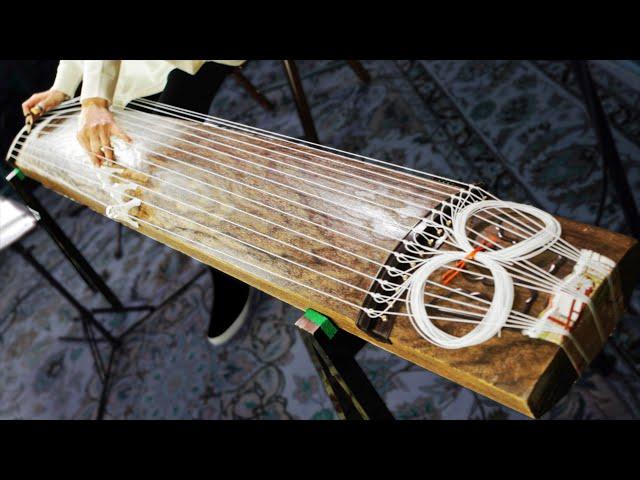
The Koto (13 string Japanese traditional instrument)
Комментарии:

How lovely she is
Ответить
Music, the true universal language.
Ответить
Rob you need to do a shamisen at some point.
Ответить
that instrument is so cool
Ответить
Wonderful
Ответить
What an Amazing Video and what an Amazing Instrument. Thanks for Sharing with us.
Ответить
I never knew a Japanese instrument originated in China.
Ответить
It’s so beautiful!!
Ответить
Since I can't find much information on it, do you know if you can bend a note on a hammered dulcimer? I'd guess it would work something like a koto, but the strings might be too sharp or taut or fragile- I wouldn't know, I don't own one at the moment, but I'd love to know if you could tell me! Keep up the great music & learning! <3
Ответить
Bruh they are making this translator earn her money they be using the most obscure technical words in wildly different languages
Ответить
That was thoroughly enjoyable to watch. Thankyou.
Ответить
The end of this video makes me want to cry
Ответить
Not gonna lie, watching, listening to her play that long piece, was so relaxing and soothing, it put a smile on my face. I felt happiness. Didn't want it to end❤. Awsome clip 👍
Ответить
Puro cargadero cuando el mentado Rob se mete a tocar al inicio con tapping
Ответить
I lived in Japan years ago this brings back many memories of my childhood there !
Ответить
Hello, where to buy one?? I m in Spain❤❤❤
Ответить
This was heartwarming
Ответить
Never thought I'd be one of those people who said they teared up watching this, but I did. 🥲
Ответить
Seen this thing in kungfu hustle 😅
Ответить
Dueling banjos kinda
Ответить
Enjoy! Have fun. That's all. It's all about experiment. Explore improvise two hearts content. God bless. God bless to you and your family's friends. God bless to all those nice people around the world
Ответить
This was a real joy to watch. 😊🤍✨🙏
Ответить
All by ear 🎉🎉🎉🎉🎉❤❤❤❤
Ответить
It's quite interesting that China's guzheng has been regarded as a Japanese musical instrument. The Chinese guzheng first emerged in the 5th century BC and has a history of over 2,700 years up to now. Even the Japanese characters all originate from China. During the Tang Dynasty in China (from the 7th century to the end of the 9th century AD), as many as thousands of Japanese people came to China to study. They learned from China in aspects such as clothing, characters, architecture, including the kimono, the tea ceremony and so on. Japan is indeed a country that is good at learning... It's the first time I've known that someone claims the Chinese guzheng is a traditional Japanese musical instrument... The Chinese guzheng has 21 strings, while the Japanese koto, which has 13 strings, might be the same type as the guzheng in the Tang Dynasty... Initially, the Chinese guzheng had only five strings, and later it gradually developed into a 12-string, 13-string instrument, and finally the modern 21-string one. Currently, the 21-string guzheng has become the most popular and standard form. Although the 21-string guzheng is the most common, there are also some guzhengs of special specifications, such as those with 18 strings, 23 strings, 25 strings, etc., which are used in different musical requirements and occasions. However, these guzhengs of special specifications are not as popular as the 21-string one.
Ответить
I would have loved seeing her playing the guitar laying on her lap and with the 'nails' like he did. I think she could have done some pretty cool stuff playing a guitar in her usual way.
Ответить
thank you for this video. <3 it was beautiful.
Ответить
Magnificent
Ответить
Just Beautiful ❤
Ответить
BEAUTIFUL ❤❤
Ответить
This sounded incredibly familiar to some Carpathian mountains traditional melodies from the Ukraine! Impressed!
Ответить
“Music is the universal language”
-Somebody I forgot the name

So, when is the fusion of guitar and koto record going to come out? That would be incredible.
Ответить
What a gorgeous instrument. But it is no better than the lady playing it. She makes it sing. I love it!
Ответить
If only she spoke a real language.
Ответить
I'm getting 'Avatar: The Last Airbender' vibes.🌪💦⛰️🔥
Ответить
I feel like i could go to sleep to this but that i also might wake up in several pieces after watching kung fu hustle ❤
Ответить
Cool sounds
Ответить
Save room music and I’m here for it
Ответить
I was depressed before i watched this
Ответить
Wow, habe gerade zum ersten Mal dieses Musikinstrument gesehen und von einer Master Spielerin ein Werk gehört.
Ich bin echt begeistert und das Lied und die Töne beruhigen irgendwie Seele

Buddhit maajya full bhalti wire 🔥
Ответить
I am from India 🇮🇳...it sounds satisfying and beautifull...
Ответить
wowwwwwwwww. americans sound so gay.
Ответить
Improvising using only the pentatonic scale can be incredibly inspiring! The simplicity of the scale opens up endless possibilities, and it allows you to focus more on expression and feel, rather than worrying about navigating all the notes of the chromatic scale. With fewer notes, you're able to create phrases that are more intentional and melodic, without the fear of hitting a wrong note. My favorite scales to work with are:
C D E G A
D E G A B
E F# G B C (which sounds exactly like the first scale you liked)
The key is learning how to make the most out of these limited notes, playing with dynamics, rhythm, and phrasing to give the music character and depth. Once you understand how to make it sound good, the pentatonic scale becomes a powerful tool for creativity and improvisation, allowing you to explore new ideas while keeping the music grounded and approachable.
❤❤❤❤❤

Ahh this video is bliss.
Ответить

























